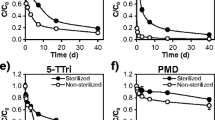Abstract
The influence of the addition of a municipal biosolid and the cationic surfactant tetradecyl trimethyl ammonium bromide (TDTMA) on the degradation of an organophosphorus insecticide, methidathion, in a soil was investigated. Before incubation, top soil samples were amended with 4% of biosolid (SB), TDTMA (SS) and both amendments (SBS). Two additional samples of top soil, unamended (Ss) and amended with the biosolid (SBs), were sterilised to check for abiotic degradation. The amendments did not markedly affect insecticide degradation in any sample, with minute changes attributed to small sorption differences. Measurements of the dehydrogenase activity (DHA) seem to support the hypothesis that methidathion degradation is carried out by soil micro-organisms. The presence of the biosolid increases methidathion persistence in the sterile samples. Experimental data were fitted to three mathematical equations: a first-order one (monophasic model), a biexponential model and the Hoerl function (biphasic models). Biphasic models better predict the results obtained in top soil amended or not, while for sterile samples all the proposed equations are good descriptors.

Similar content being viewed by others
References
Beulke S, Malkomes H-P (2001) Effects of the herbicides metazachlor and dinoterb on the soil microflora and the degradation and sorption of metazachlor under different environmental conditions. Biol Fertil Soils 33:467–471
Beulke S, Dubus IG, Brown CD, Gottesbüren B (2000) Simulation of pesticide persistence in the field on the basis of laboratory data. A review. J Environ Qual 29:1371–1379
Camiña F, Trasar-Cepeda C, Gil-Sotres F, Leirós C (1998) Measurement of dehydrogenase activity in acid soils rich in organic matter. Soil Biol Biochem 30:1005–1011
Cullingtong JE, Walker A (1999) Rapid biodegradation of diuron and other phenylurea herbicides by a soil bacterium. Soil Biol Biochem 31:677–686
El-Nahhal Y, Undabeytia T, Polubesova T, Mishael YG, Nir S, Rubin B (2001) Organo-clay formulations of pesticides: reduced leaching and photodegradation. Clay Sci 18:309–326
Garrido A, Martínez JL, Pablos MC (2001) Estudio de la contaminación por plaguicidas en aguas superficiales y subterráneas de la provincia de Almería mediante GC–ECD, GC–NPD y GC–MS/MS. Phytoma 129:75–77
Getzin LW (1970) Persistence of methidathion in soils. Bull Environ Contam Toxicol 5:104–110
Gustafson DI, Holden LR (1990) Nonlinear pesticide dissipation in soil: a new model based on spatial variability. Environ Sci Technol 24:1032–1038
Hernández F, Serrano R, Miralles MC, Font N (1996) Gas and liquid chromatography and enzyme linked immuno sorbent assay in pesticide monitoring of surface water from the Western Mediterranean (Comunidad Valenciana, Spain). Chromatographia 42:151–158
Hoerl AE (1954) Fitting curves to data. In: Perry JH (ed) Chemical business handbook. McGraw-Hill, New York, pp 55–57
Kalos MH, Whitlock PA (1986) Monte Carlo methods, vol 1: basics. Wiley, New York
Liu X, Cole MA (1996) Minimum effective compost addition for remediation of pesticide-contaminated soil. In: Bertoldi M, Sequi P, Lemures B, Papi T (eds) The science of composting. Blackie Academic and Professional, Glasgow
Merlin G, Lissolo T, Morel V, Rossel D, Tarradellas J (1995) Precautions for routine use of INT-reductase activity for measuring biological activities in soil and sediments. Environ Toxicol Water Qual 10:185–192
Metzger LOY, Munier-Lamy C, Choné T, Belgy MJ, Andreux F, Védy JC (1996) Fate of a sulfonylurea herbicide in an alluvial soil, as shown by experimental degradation of pyrimidine-2-14C-labeled primsulfuron. Chemosphere 33:625–633
Moorman TB, Cowan JK, Arthur EL, Coats JR (2001) Organic amendments to enhance herbicide biodegradation in contaminated soils. Biol Fertil Soils 33:541–545
Nannipieri P, Grego S, Ceccanti B (1990) Ecological significance of the biological activity in soil. In: Bollag J-M, Stotzky G (eds) Soil biochemistry. Dekker, New York, pp 293–355
Reyes CC, Zimdahl RL (1989) Mathematical description of trifluralin degradation in soil. Weed Sci 37:604–608
Riise G, Madsen H, Krogstad T, Pettersen MN (2001) Association of the fungicide propiconazole with size fractionated material from a silty clay soil—S.E. Norway. Water Air Soil Pollut 129:245–257
Romero E, Dios G, Mingorance MD, Matallo MB, Peña A, Sánchez-Rasero F (1998) Photodegradation of mecoprop and dichlorprop on dry moist and amended soil surfaces exposed to sunlight. Chemosphere 37:577–589
Sánchez L, Mingorance MD, Peña A (2000) Microwave assisted process for methidathion in water samples for physicochemical studies. Analyst 125:1199–1203
Sánchez L, Romero E, Sánchez-Rasero F, Dios G, Peña A (2003) Enhanced soil sorption of methidathion using sewage sludge and surfactants. Pest Manage Sci (in press)
Sánchez-Camazano M, Arienzo M, Sánchez-Martín MJ, Crisanto T (1995) Effect of different surfactants on the mobility of selected non-ionic pesticides in soil. Chemosphere 31:3793–3801
Sánchez-Camazano M, Iglesias-Jiménez E, Sánchez-Martín MJ (1997) City refuse compost and sodium dodecyl sulphate as modifiers of diazinon leaching in soil. Chemosphere 35:3003–3012
Secretaría General Técnica (ed) (1986) Métodos oficiales de análisis (Tomo III). Ministerio de Agricultura, Pesca y Alimentación (Dirección General de Política Alimentaria), Madrid
Wolf W de, Feijtel T (1998) Terrestrial risk assessment for linear alkyl benzene sulfonate (LAS) in sludge-amended soils. Chemosphere 36:1319–1343
Zimdahl R, Cranmer BK, Stroup W (1994) Use of empirical equations to describe dissipation of metribuzin and pendimethalin. Weed Sci 42:241–248
Acknowledgements
This research was supported by National Research Project (CICYT AMB97-1222). Lourdes Sánchez thanks Ministerio de Educación y Ciencia for a grant received. D. Rubí and M.D. Maroto are kindly acknowledged for their technical assistance.
Author information
Authors and Affiliations
Corresponding author
Rights and permissions
About this article
Cite this article
Sánchez, L., Peña, A., Sánchez-Rasero, F. et al. Methidathion degradation in soil amended with biosolids and a cationic surfactant: use of different kinetic models. Biol Fertil Soils 37, 319–323 (2003). https://doi.org/10.1007/s00374-003-0593-6
Received:
Accepted:
Published:
Issue Date:
DOI: https://doi.org/10.1007/s00374-003-0593-6




